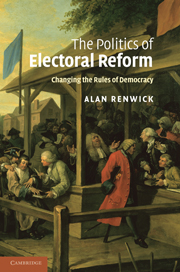Book contents
- Frontmatter
- Contents
- List of tables
- List of figures
- List of abbreviations
- Acknowledgements
- 1 Introduction
- PART I Building blocks
- PART II Elite majority imposition
- 5 France: the recurrent game of electoral reform
- 6 Italy: the search for stability
- 7 Japan: the persistence of SNTV
- 8 Elite majority imposition: comparative analysis
- PART III Elite–mass interaction
- Appendix: glossary of electoral system terminology
- Bibliography
- Index
8 - Elite majority imposition: comparative analysis
Published online by Cambridge University Press: 04 May 2010
- Frontmatter
- Contents
- List of tables
- List of figures
- List of abbreviations
- Acknowledgements
- 1 Introduction
- PART I Building blocks
- PART II Elite majority imposition
- 5 France: the recurrent game of electoral reform
- 6 Italy: the search for stability
- 7 Japan: the persistence of SNTV
- 8 Elite majority imposition: comparative analysis
- PART III Elite–mass interaction
- Appendix: glossary of electoral system terminology
- Bibliography
- Index
Summary
Armed with the case knowledge developed in the preceding chapters, I now seek to analyse the elite majority imposition type of electoral reform in greater depth. The defining features of enacted reforms falling into this type are that politicians dominate the reform process and that those politicians primarily seek to advance their own power. Though these features imply that reforms by elite majority imposition are simple compared to those involving elite–mass interaction, still they contain complexities that raise important analytic questions. Two are particularly important, and I devote most time to them. The first relates to politicians' goals: what are they, and what shapes them? Are they dominated by the maximization of short-term seat shares, or are other considerations also important? Second, why is it possible for reforms of this type to occur at all? What determines whether manipulation of the electoral system for personal or partisan gain is seen as legitimate (or at least tolerable) rather than illegitimate? What determines whether perceptions of illegitimacy constrain politicians' actions?
I also address the other building blocks surveyed in Part I. How far are actors' preferences shaped by uncertainty and misperception? To what degree are their preferences constrained by cognitive limits on the alternatives that actors perceive, and what determines where these limits lie? How far can skilful leadership by key individuals change outcomes? What is the role of institutions in translating preferences into outcomes?
- Type
- Chapter
- Information
- The Politics of Electoral ReformChanging the Rules of Democracy, pp. 138 - 166Publisher: Cambridge University PressPrint publication year: 2010



